#without needing to sub one out for something capable of Mega Evolution
Explore tagged Tumblr posts
Text
I’ve made the unfortunate connection between Megas being available in Kanto in LGPE and Terastalisation being available in a very small part of Unova that isn’t in the Unova games and has no reason to bring the gimmick to the mainland in the SV DLC and my firm belief that they should do both Johto remakes (which will obviously include revisiting Kanto again) and Unova remakes in Gen 10, which combined with how I like to see Kalos and Paldea as a pair (especially with Z-A coming out in the same generation as SV) gives me the unfortunate idea of bringing elitism to Johto but on the plus side, sparkly crystals for everyone in Unova!
#Mega Evolution does not need five regions. It’s bad enough it already has four#and worse Mega Evolution gets an extra region here but technically Terastalising doesn’t#anyway I don’t actually see them adding any of these gimmicks to Johto/Unova remakes so Johto is safe for now#your team of favourites that are allowed in Johto is allowed to be used#without needing to sub one out for something capable of Mega Evolution#sorry I do actually like Mega Evolution but when it’s so restricted (and Mega Heracross exists) and everything else can be used by anyone#it’s not hard to see what the better option is#also I really love sparkly crystals so Terastalisation appeals the most to me#my Scarlet and Violet teams are entirely composed of Paldean Pokémon#(I’m counting the Proto Beasts and Neo Swords as Paldean even though they’re in the Blueberry Dex instead. They’re only found in Paldea)#they’re all level 100 but if they tried to do cool stuff in Kalos they would fail miserably because none of them have a Mega#(even though Luna and Knight look like Megas)#pokémon#mega evolution#terastal#johto#unova
1 note
·
View note
Text
Krenko’s Guide to Pokemon: Abra Line
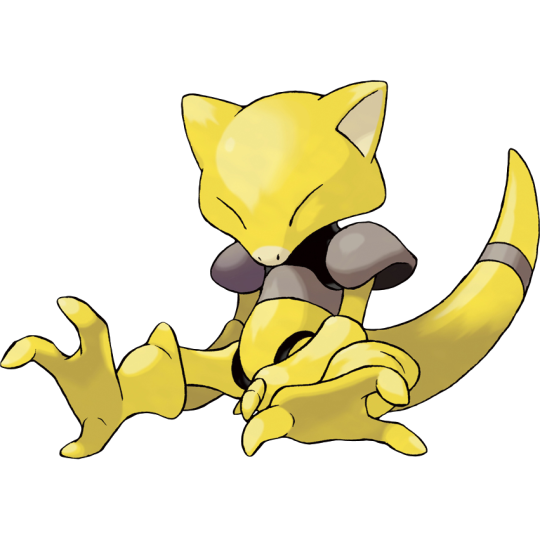
Some Pokemon ebb and flow through generations, becoming stronger or weaker as the Meta changes, sometimes being powerful sometimes being unusable. Alakazam is not one of those Pokemon. Alakazam has always been strong. And Alakazam will probably always be strong. DESIGN: I have no idea what these things are supposed to be. It’s sort of rat-ish but not really. Maybe a possum? I have no idea. Is it a mammal? Is it scaly? Is it chitinous? I think it’s chitinous. But you know what? This is a good thing. It’s such a unique creature that it really stands out among those derived from real and mythological things. Kadabra looks like a reasonable bigger Abra. It stands upright, it has a moustache, it has psychic symbols on its head and stomach, its chest armor thickens, and it has that huge, meaty tail. It also has a bendy spoon, popularized by famous magical Jew ‘Uri Geller,’ who Kadabra takes his Japanese name, Yungerer, from. Him suing their asses is why Kadabra tends not to show up much outside of the games.
Kadabra to Alakazam is less pronounced but still interesting. The moustache becomes huge and majestic, the ‘armor’ adds bracers and kneepads, the feet thicken, and the tail... falls off? Where does its tail go? It’s a weird design decision, but all three look great and interesting.
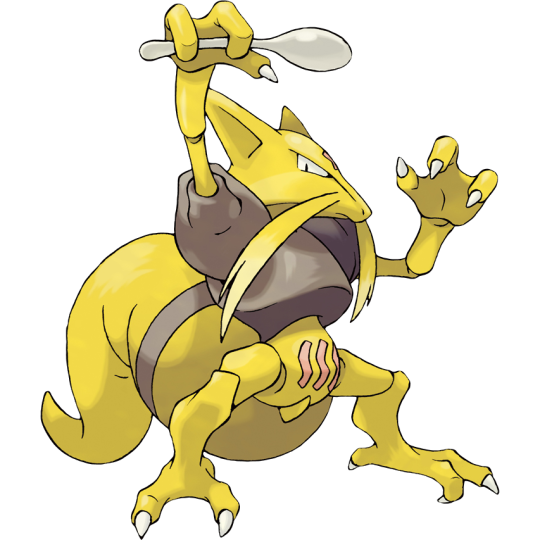
And then at the extreme end is Mega Alakazam. Mega Alakazam looks exactly what you’d expect it to look like. It’s head is spikier, its facial hair is more majestic, and it has so many spoons. It also gives off a very Hindu vibe, seated in meditation like a classic guru. EVOLUTIONS: Abra to Kadabra at level 16 is pretty standard, as both forms are overall about on par with those of starters. Then Kadabra to Alakazam is a trade evolution. I’m of very mixed feelings about Trade Evolutions, because Trade Evolutions don’t really do what the’re supposed to do. Yes, they require a friend to help you, but it’s always trade and trade back, never ‘new owner gets to use the evolved form.’ Back in the early days of Pokemon this was actually a big part of getting people together, but now with online trading it feels a bit outdated. Still, it’s grandfathered in and I can’t really complain, I just wish there was a way they could rework it to still be ‘you need help from a friend’ without having to do the ‘trade/trade back.’
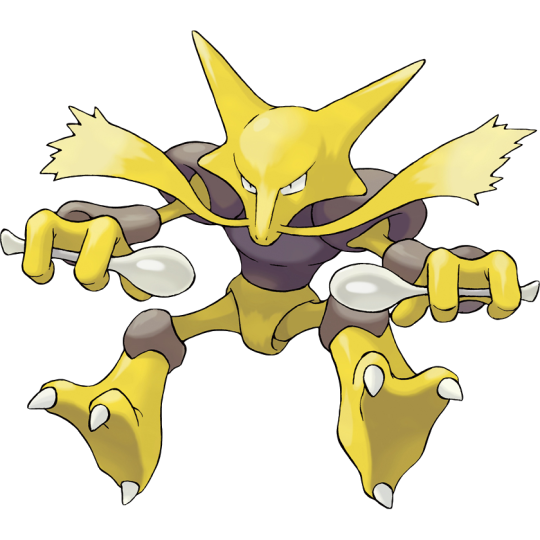
Mega Alakazam is cool but so viciously unnecesarry. Alakazam was already a very powerful Pokemon, and it really, really didn’t need a Mega Evolution. Sure, Uber Tiers are a thing people want to do, and if you want to fight against Mewtwo and Arceus you need Mega Alakazam, but Legendaries tend to be banned from tournament play anyway. TYPING: Pure psychic is technically a sub-par type, as more things resist it than are weak to it, and it’s weak to more things than it resists. Still, these aren’t major drawbacks. More of a drawback is that Psychic is a very common type, so Alakazam has a lot of competition among its type.
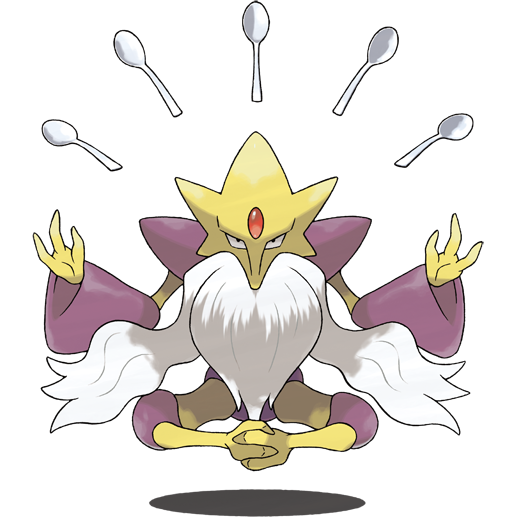
STATS: Alakazam’s stat total is a perfectly average 500... Except it’s stat distribution is amazing. With garbage HP, Attack, and Defense, Alakazam has 135 Special and 120 Speed, both incredible. Alakazam is more than capable of one-shotting a lot of pokemon with special attacks, and it’s usually going to go first. It’s special defense is decent, though not enough to make it want to eat an attack with such low HP. Overall, this is a great distribution for an all out attacker. Mega Alakazam’s got 175 Special Attack and 150 speed. Because it totally needed that.
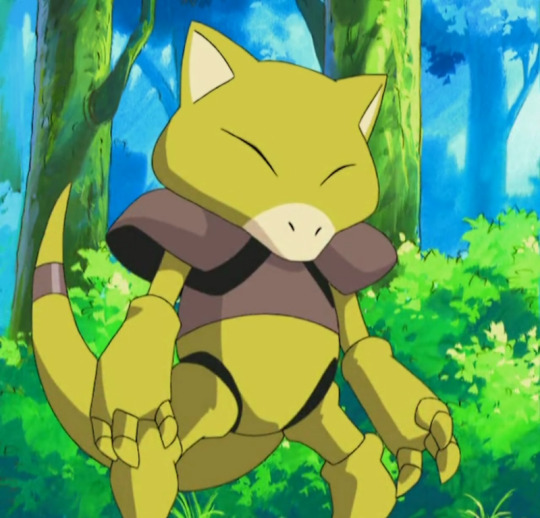
ABILITIES: Synchronize, Alakazam’s first ability, is not helpful. If Alakazam becomes afflicted by a status effect, the opponent gets it, too, but because this only applies to effects inflicted by the opponent and not self-inflicted ones, there’s really no way to take advantage of this. Inner Focus prevents Flinching and Intimidate. As Alakazam has no Attack worth noting, being intimidated doesn’t matter. As Alakazam is hella fast, Flinching only matters against Fake Out. Immunity to Fake Out isn’t nothing, especially in doubles, but this is not Alakazam’s best option. Magic Guard, Alakazam’s hidden ability, prevents Alakazam from taking damage from anything that isn’t an attack. This includes burn, poison, weather, leech seed, Life Orb, Spikes, and any form of recoil. This is just super good, and basically means any Alakazam not planning to go Mega gets Life Orb no questions asked. Mega Alakazam gets Trace, which copies an opponent’s ability at first opportunity. This is a serious downgrade from Alakazam, but +40 Special Attack and +30 Speed so shut up and enjoy your Mega Alakazam.

MOVES: Alakazam has ONE JOB and that’s to spam Psychic with STAB and Life Orb and 135 base special and max Special EVs so everything dies. Steel, Dark, and Psychic types are resistant to Psychic. Fortunately, Focus Blast is good against both Steel and Dark, and other Psychic types are weak to Shadow Ball.
There, you’ve got an Alakazam. With one slot to spare. You could pick up Psyshock to deal with enemies with high Special Defense, or Energy Ball or Dazzling Gleam for more coverage.
Nasty Plot’s pretty great. If you manage to get a free turn to use it, it basically guarantees Alakazam’s downing anything in one shot. Thunder Wave is always useful. Encore can trap an opponent in a sub-optimal move choice. In the event of Mega Alakazam (but not so much normal Alakazam), Recover’s a reasonable option. With higher defenses and a lack of Magic Guard, spending a turn to clean up damage can be useful. General frailty also means it might benefit Alakazam to set up a Substitute if it has a moment. It doesn’t need it to protect from status conditions and such, but having that shield up for if something does outspeed with a physical attack can be very important. Every Alakazam should have Psychic and Focus Blast. After that, it’s all based on personal strategy.
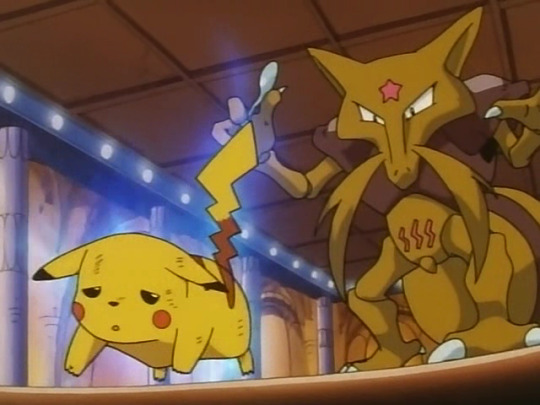
OVERALL: Alakazam was one of the best pokemon back in Gen 1 and is still great for all the same reasons. When you’re fast and do a lot of damage, you have a competitive place. Magic Guard is just gravy.
I still have no idea if its chitinous, mammalian, or what an I love that I don’t know that.
22 notes
·
View notes
Text
Making Art for Cheap: The Current Cost of Game Development
Gamers tend to complain that gaming has become more expensive in recent years. In actuality, gaming is becoming somewhat more accessible. In parallel, game development also used to be far more expensive to get into, but in recent years, many resources have been made available to make development easier and cheaper - often even free. While originally too expensive for common hobbyists, game development has become inexpensive enough to be accessible to all, and is on the verge of becoming a popular art form, much like music and painting.
Game development is usually seen as expensive by default. Even in the 80’s, when video games first started to become widespread, they would cost a few-hundred-thousand dollars to create. Steve Theodore, a developer who worked on games such as Half-Life and Halo 3, says that nowadays, triple-A (aka “blockbuster,” but for games) budgets can reach the hundred-millions, and predicts that those numbers will continue to rise. Due to the steadily improving speeds of processors and capabilities of hardware, games are consistently expected to become more outstanding and amazing – and thus, more costly – every year.
As a result of these larger budgets, these triple-A games are also fairly expensive for gamers to play, currently selling for about $70 a copy, and not all of them live up to the demanded quality for their scale. Reviewers like Caddicarus on YouTube state in many reviews that a lot of high-budget games are “not worth the price I paid,” and players on social media tell others to “wait for a sale before buying this game.” There is almost an air of entitlement as to how much a game should cost when compared to how much a player enjoys it, and, in many ways, that makes sense. Paying $70 to a triple-A developer for a poorly-made game does not feel like a fair trade to most people.
But not every game is $70; PC games on the online distributor Steam average at around $6 - $10, and there are multitudes of games on sale for much cheaper. On the “Free to Play” page alone, there are 1,415 games listed. Players don’t need to pay a dime to be able to play even a large selection of games, and this is becoming the norm. This makes the steadily rising cost of mainstream triple-A games look a bit pricey in comparison.
But even in that case, while those prices have indeed been rising, they have not been keeping up with inflation. In 1990, the average cost of a new game to play on a Nintendo Entertainment System was $50. According to the CPI Inflation Calculator, that would be around $96 as of the time of this writing - a fair chunk more than the $70 for high-end games of today. The actual cost of video games hasn’t risen at the rate they could have - and that’s still overlooking the waves of sales and discounts that games often go through.
The lower costs of games is a result of the lower costs of game development. While triple-A budgets are obviously still rising, much of that cost is being directed toward marketing, rather than actual development. Plus, there’s many more small, independent companies making games for cheap than there used to be. Minecraft, one of the highest-profiting video games in history, was started as a hobby project, costing the developers next to nothing. While the game was in beta, it was $12 to play. This comparatively low price tag was due to that lack of a large budget. Another popular independent game is Undertale, still available for most systems at an outrageously high price of 10 whole dollars. Again, the creator of Undertale, Toby Fox, did most of the work himself, with a bit of help from friends, not expecting much of a return. Yet, because it became the source of many memes and the inspiration to countless creative projects, the game sold enough that Fox earned far more than he invested in creating it. Not all independent games get as popular as Minecraft or Undertale, of course, but that doesn’t matter much when a $5 game still results in profit.s
That’s not even touching on the 1,415 free games available on Steam. Many of them are free to download and get into, but offer upgrades or DLC as microtransactions. While a company can make a good chunk of change from these transactions, the games are still playable from the start for free, which shows that the development was at least cheap enough to suffer some sacrifice for the initial release.
Additionally, a lot of those Free to Play games are free forever. Often short and, again, independently developed, these games are made solely for the sake of the art. Some of the developers of these artistic games may have sacrificed some cash to bring them to fruition, but the majority of them were made for free, put together from homemade code and art and music.
[Bad transition, fix later] Even then, there are also many free resources available to create games with. Unity and Unreal are two of the most popular engines to start with; both are powerful, professional-level systems that let creators dive in without too much training – but they have plenty of in-depth training available as well. Aspiring creators can jump in and begin practicing with the available tutorials and tips, getting ready to dive into the advanced aspects later on. There’s also Blender 3D for making homemade assets, and plenty of cheap image editors for making 2D assets; aspiring creators do not need to purchase a pricey copy of Photoshop or Maya anymore.
These inexpensive resources are what’s making game development more popular and commonplace - and from that, even more artistic. The same rise seen in pop music, painting, and even filmmaking as popular forms of art is happening now with games. Folk music was born to poor singers playing cheap instruments, and that begat blues, and then blues begat rock ‘n’ roll, which begat pop and hip-hop and rap, which are now omnipresent in modern media. The music of the poor has always been more popular than the grand orchestras and symphonies of the rich, because anyone could pick up a guitar, raise their voice, and sing along with the folk songs, blues, and rock ‘n’ roll. Everyone could join in, and that made it popular. Now, game development is turning the same direction; almost anyone can join in. And, as more developers do join in, they pave the way to make it even easier and more accessible to an even higher number of aspiring creators.
An example of this evolution of accessibility is a hobby called “modding” – short for “modifying.” For years now, gamers have been taking games that already exist, reverse-engineering them, and then changing them for their own enjoyment. These reverse-engineered techniques are then passed on, allowing more creatively-minded fans to use those resources to make their own changes. These modifications – “mods” – have been around for decades, and have been the jumping-off-point for many fans into becoming game developers of their own. For many fans, modding is what gets them into game development as a hobby. It’s an easy way to learn the basics of game logic and asset creation without being overwhelmed by deep code and project management. These fans then transform into hopeful game devs, wanting to create their own artistic projects using what they’ve learned.
Of course, some might argue that paying for these more expensive programs and professionally-produced assets makes for a better quality game in the end, and that can be true. However, more and more affordable resources are being created and developed constantly. Even for someone who can’t draw or compose, there are still plenty of good-quality stand-ins for little to no cost, and the selection is still growing. [examples] And, as always, practice makes perfect; with enough time and effort, someone who can’t draw well can learn to, and then create their own assets.
Yes, sometimes you can still tell when a game was made on a low budget. Shovelware games - named for the way they seem to be “shoveled” out of a failing developer’s back door – are usually horrendous. But most of the time, these games are also extremely cheap, or even free. They may not be diamonds, but at least they don’t cost as much as diamonds. In contrast, triple-A games are far more expensive, but are also frequently criticized for not being worth their price. Shovelware games are criticized for being bad, but are inevitably waved off with, “Well, you get what you pay for.”
In fact, many of these games exist almost entirely due to the fact that game development is more accessible. Hobbyists can get their feet wet and find out where they fall short without dropping too much of a budget into something that may flop. Additionally, many hobby projects turn out to be outstanding for what they are. Accessibility can surely breed low-quality content, but high-quality content will shine through and last longer. Gems hidden in the bog of ugly messes stand out and become popular, just as many artists and musicians do. When every song on the radio begins to sound the same, one that genuinely sounds new and fresh will overdrive a musician to the top of the charts. The same thing happens with these small-scale indie games.
Indie games are becoming increasingly popular in the eyes of most reviewers. Hollow Knight, Shovel Knight, Ori and the Blind Forest, Celeste, and many more have all been praised for being beautiful, fun games, and they’ve all been developed in just the last few years. Indie games are sweeping through the markets, showing up on every platform, and, since they’re fairly cheap, gamers and reviewers alike are happily claiming that they are worth buying, playing, and supporting.
The same cannot be said of the triple-A market. The publisher EA, one of the few mega-corporations behind game development, is notorious for releasing games of sub-par quality chock full of microtransactions on top of high base-game prices. The Sims series, one of their forefront staples, has hundreds of DLC packs, and those packs average at $30 - half the price of the base game. Other developers, like Bethesda and Ubisoft, are ridiculed for releasing “unfinished” games. Bethesda’s Fallout series and Ubisoft’s Assassin’s Creed series are full of bugs and glitches, and are often required to make updates and patches in order to push the games into what players call “suitable for sale” territory.
Still, not all indie games stand out. Some try their best and fall very flat. Mighty No. 9, a highly anticipated, Mega-Man-inspired Kickstarter game, was full of bugs and glitches in place of any good story or gameplay. And on the flipside, triple-A, high-budget games do not always come out as trash. There is, after all, a reason the triple-A developers are called triple-A. In general, many fans have high hopes from big-budget games; they are meant to be beautiful, powerful, fun works of art. For example, Nintendo is very well-known for putting out amazing works, to the point that “Nintendo Polish” is expected as their norm. However, that polish adds extra dollars to the pricetag, and, regrettably, Nintendo does not always live up to the the term. Lately, many of the powerful developers have been “slacking off,” and the independent devs are filling in the holes. More and more, indie games are being praised, and triple-A’s are being criticized. Again, it’s not always true, but it’s becoming more true as time goes on.
Artists through the ages have used writing, painting, movies, music, and more to express themselves. Today, they are adding game development to the list. Development in the early years of the gaming age required high levels of technical knowledge and skill, but nowadays, it has changed enough that one can take it on as a hobby. Anyone who can draw, write, or express themselves are able to get into game development.
Because the cost of getting into game development is almost nothing, if you’re willing to make assets on your own, you can start. So, what are you waiting for? Get out there and start.
2 notes
·
View notes